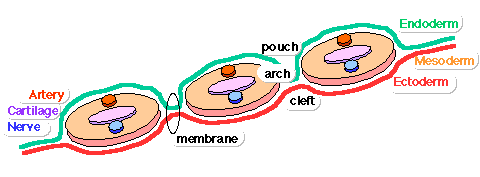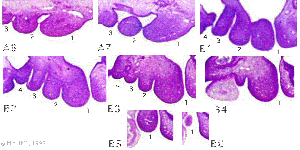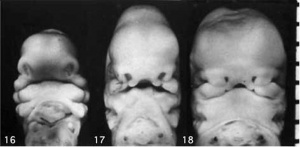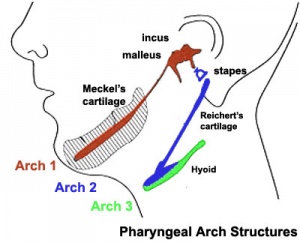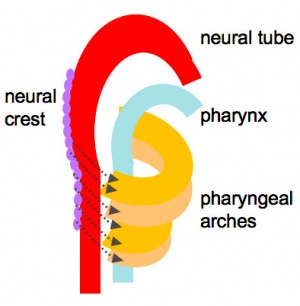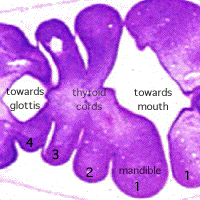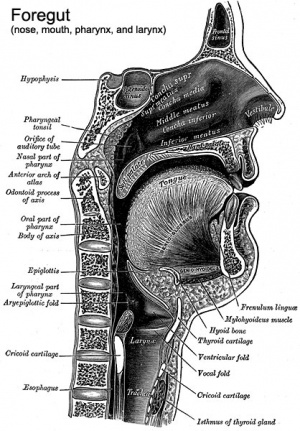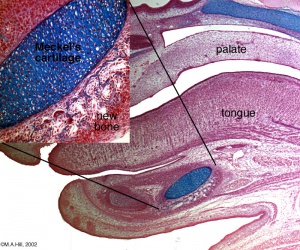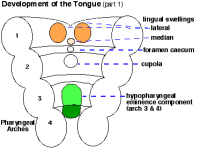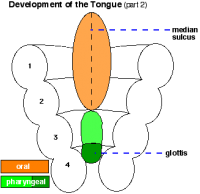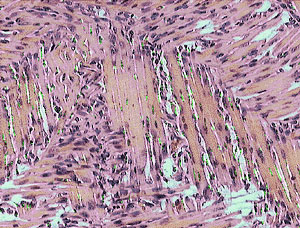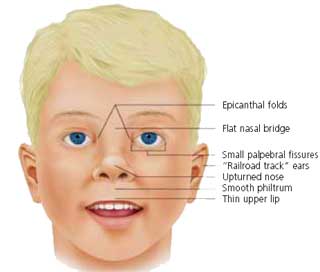2009 Lecture 11: Difference between revisions
| (37 intermediate revisions by the same user not shown) | |||
| Line 6: | Line 6: | ||
The face is the anatomical feature which is truly unique to each human, though the basis of its general development is identical for all humans and similar to that seem for other species. The face has a complex origin arising from a number of head structures and sensitive to a number of teratogens during critical periods of its development. The related structures of upper lip and palate significantly contribute to the majority of face abnormalities. | The face is the anatomical feature which is truly unique to each human, though the basis of its general development is identical for all humans and similar to that seem for other species. The face has a complex origin arising from a number of head structures and sensitive to a number of teratogens during critical periods of its development. The related structures of upper lip and palate significantly contribute to the majority of face abnormalities. | ||
The head and neck structures are more than just the face, and are derived from pharyngeal arches 1 - 6 with the face forming from arch 1 and 2 and the frontonasal prominence. Each arch contains similar Arch components derived from endoderm, mesoderm, neural crest and ectoderm. These components though will form different structures depending on their arch origin. Because the head contains many different structures also review notes on Special Senses ([senses.htm eye, ear, nose]), Respiratation ([respire.htm pharynx]), Integumentary ([skin10.htm Teeth]), Endocrine ([endocrine.htm thyroid, pituitary]). | The head and neck structures are more than just the face, and are derived from pharyngeal arches 1 - 6 with the face forming from arch 1 and 2 and the frontonasal prominence. Each arch contains similar Arch components derived from endoderm, mesoderm, neural crest and ectoderm. These components though will form different structures depending on their arch origin. Because the head contains many different structures also review notes on Special Senses ([http://embryology.med.unsw.edu.au/Notes/senses.htm eye, ear, nose]), Respiratation ([http://embryology.med.unsw.edu.au/Notes/respire.htm pharynx]), Integumentary ([http://embryology.med.unsw.edu.au/Notes/skin10.htm Teeth]), Endocrine ([http://embryology.med.unsw.edu.au/Notes/endocrine.htm thyroid, pituitary]). [http://embryology.med.unsw.edu.au/Movies/usoundab/Cleft1.htm Ultrasound - Cleft lip/palate] | ||
:'''Lectopia Audio:''' Lecture Date: 31-08-2009 Lecture Time: 12:00 Venue: CLB 5 Speaker: Mark Hill [http://lectopia.elearning.unsw.edu.au/ilectures/ilectures.lasso?ut=153&id=48828 Head and Neck] | |||
[[2010_Lecture_11|2010 Lecture - Head Development]] | |||
==Lecture Objectives== | ==Lecture Objectives== | ||
* List the main structures derived from the pharyngeal arches, pouches and clefts. | * List the main structures derived from the pharyngeal arches, pouches and clefts. | ||
* Know the stages and structures involved in the development of the face. | * Know the stages and structures involved in the development of the face. | ||
* Predict the results of abnormal development of the face and palate. | * Predict the results of abnormal development of the face and palate. | ||
* Briefly summarise the development of the tongue. | |||
== Textbook References == | == Textbook References == | ||
| Line 48: | Line 52: | ||
===Neural Crest === | ===Neural Crest === | ||
* Mesenchyme invaded by neural crest generating connective tissue components | |||
* cartilage, bone, ligaments | |||
* arises from midbrain and hindbrain region | |||
===Arch Features=== | ===Arch Features=== | ||
| Line 96: | Line 100: | ||
==Arch Cartilage== | ==Arch Cartilage== | ||
[[File:Meckel.jpg|thumb|Meckel's cartilage, first pharyngeal arch]] | |||
[[File:Pharyngeal_arch_cartilages.jpg|thumb|Pharyngeal arch cartilages]] | |||
* Arch 1 - Meckel's cartilage, horseshoe shaped | * Arch 1 - Meckel's cartilage, horseshoe shaped | ||
** dorsal ends form malleus and incus | ** dorsal ends form malleus and incus | ||
| Line 137: | Line 143: | ||
==Anterior Pituitary== | ==Anterior Pituitary== | ||
[[File:Historic-pituitary.jpg|thumb|Pituitary]] | |||
* not a pouch structure | * not a pouch structure | ||
* boundary epitheilal ectoderm in the roof of the pharynx | * boundary epitheilal ectoderm in the roof of the pharynx | ||
| Line 202: | Line 208: | ||
* bones do not fuse, fibrous sutures 1. allow distortion to pass through birth canal 2. allow growth of the brain | * bones do not fuse, fibrous sutures 1. allow distortion to pass through birth canal 2. allow growth of the brain | ||
* 6 fontanelles, posterior closes at 3 months, anterior closes at 18 months | * 6 fontanelles, posterior closes at 3 months, anterior closes at 18 months | ||
==Palate== | |||
The palate has two key stages of development during embryonic and an early fetal involving the fusion of structures (epithelia to mesenchymal). | |||
=== Embryonic=== | |||
Primary palate, fusion in the human embryo between stage 17 and 18, from an epithelial seam to the mesenchymal bridge. | |||
[[File:Stage17-18 Primary palate.gif]] | |||
===Fetal=== | |||
Secondary palate, fusion in the human embryo in week 9. This requires the early palatal shelves growth, elevation and fusion during the early embryonic period. The fusion event is to both each other and the primary palate. [[:File:Palatal shelves animation.gif|palatal shelf elevation]] | [[:File:palate.gif|secondary palate]] | |||
==Ear Auricles== | ==Ear Auricles== | ||
* form from 6 hillocks (week 5) | * form from 6 hillocks (week 5) | ||
* 3 on each of arch 1 and 2 | * 3 on each of arch 1 and 2 | ||
==Tongue Development== | ==Tongue Development== | ||
[[File:Tongue1.png|200px]] [[File:Tongue2.png|200px]]] [[File:Tongue3.png|200px]]] | |||
* | * Ectoderm of the first arch surrounding the stomodeum forms the epithelium lining the buccal cavity. | ||
* | * Also the salivary glands, enamel of the teeth, epithelium of the body of the tongue. | ||
* | ** As the tongue develops "inside" the floor of the oral cavity, it is not readily visible in the external views of the embryonic (Carnegie) stages of development. | ||
* | |||
* | * Contributions from all arches, which changes with time | ||
* begins as swelling rostral to foramen cecum, '''median tongue bud''' | |||
* Arch 2 - initial contribution to surface is lost | ** Arch 1 - oral part of tongue (ant 3/2) | ||
** Arch 2 - initial contribution to surface is lost | |||
** Arch 3 - pharyngeal part of tongue (post 1/3) | |||
** Arch 4 - epiglottis and adjacent regions | |||
[[:File:tongue.gif|tongue development animation]] | [http://embryology.med.unsw.edu.au/Movies/larsen/tongue.mov Development of the Tongue] | |||
* | ===Tongue muscle=== | ||
[[File:Tongue-muscle.jpg|thumb|tongue muscle]] | |||
* Tongue muscles originate from the somites. Tongue muscles develop before masticatory muscles and is completed by birth. | |||
* Masticatory muscles originate from the somitomeres. These muscles develop late and are not complete even at birth. | |||
===Salivary Glands=== | ===Salivary Glands=== | ||
| Line 255: | Line 280: | ||
===Cysts=== | ===Cysts=== | ||
* | * Many different types | ||
=== Facial Clefts=== | === Facial Clefts=== | ||
| Line 268: | Line 292: | ||
===Fetal Alcohol Syndrome=== | ===Fetal Alcohol Syndrome=== | ||
[[File:FASface.jpg]] | [[File:FASface.jpg|left]] | ||
Due to alcohol in early development (week 3+) leading to both facial and neurological abnormalities | |||
* lowered ears, small face, mild+ retardation | * lowered ears, small face, mild+ retardation | ||
* Microcephaly - leads to small head circumference | * Microcephaly - leads to small head circumference | ||
| Line 278: | Line 301: | ||
* Low nasal bridge | * Low nasal bridge | ||
* Indistinct Philtrum - vertical grooves between nose and mouth | * Indistinct Philtrum - vertical grooves between nose and mouth | ||
* | * Thin upper lip | ||
* Micrognathia - small jaw | * Micrognathia - small jaw | ||
Exposure of embryos in vitro to ethanol simulates premature differentiation of prechondrogenic mesenchyme of the facial primordia (1999) | Exposure of embryos in vitro to ethanol simulates premature differentiation of prechondrogenic mesenchyme of the facial primordia (1999) | ||
[http://embryology.med.unsw.edu.au/Defect/page5a.htm Fetal Alcohol Syndrome] | |||
==Molecular Mechanisms== | ==Molecular Mechanisms== | ||
| Line 454: | Line 479: | ||
* '''Pubmed''' [http://www.ncbi.nlm.nih.gov/sites/gquery?itool=toolbar&cmd=search&term=pharyngeal_arch pharyngeal arch] | [http://www.ncbi.nlm.nih.gov/sites/gquery?itool=toolbar&cmd=search&term=head_development head development] | [http://www.ncbi.nlm.nih.gov/sites/gquery?itool=toolbar&cmd=search&term=face_development face development] | | * '''Pubmed''' [http://www.ncbi.nlm.nih.gov/sites/gquery?itool=toolbar&cmd=search&term=pharyngeal_arch pharyngeal arch] | [http://www.ncbi.nlm.nih.gov/sites/gquery?itool=toolbar&cmd=search&term=head_development head development] | [http://www.ncbi.nlm.nih.gov/sites/gquery?itool=toolbar&cmd=search&term=face_development face development] | | ||
==Movies== | |||
{| border='0px' | |||
|- | |||
| [[File:Face 001 icon.jpg|90px|link=Development_Animation_-_Face]] | |||
| [[File:Palate_001 icon.jpg|90px|link=Development_Animation_-_Palate 1]] | |||
| [[File:Palate_002 icon.jpg|90px|link=Development_Animation_-_Palate 2]] | |||
| [[File:Tongue_001 icon.jpg|90px|link=Development_Animation_-_Tongue]] | |||
|- | |||
| [[Development_Animation_-_Face|Face]] | |||
| [[Development_Animation_-_Palate 1|Palate 1]] | |||
| [[Development_Animation_-_Palate 2|Palate 2]] | |||
| [[Development_Animation_-_Tongue|Tongue]] | |||
|- | |||
|} | |||
== UNSW Embryology Links == | == UNSW Embryology Links == | ||
* '''Notes:''' [http://embryology.med.unsw.edu.au/Notes/head.htm Head and Neck Development] | [http://embryology.med.unsw.edu.au/Notes/head2.htm Head Abmormalities] | [http://embryology.med.unsw.edu.au/Notes/head3.htm Stage 13/14 Head sections] | [http://embryology.med.unsw.edu.au/Notes/head4.htm Stage 22 Human head sections] | [http://embryology.med.unsw.edu.au/Notes/head5.htm Selected Human high power (st22)] | [http://embryology.med.unsw.edu.au/Notes/face.htm Face] | [http://embryology.med.unsw.edu.au/Notes/face6.htm Primary Palate] | [http://embryology.med.unsw.edu.au/Notes/face2.htm Face Abnormalities] | [http://embryology.med.unsw.edu.au/Notes/head6.htm Tongue] | [http://embryology.med.unsw.edu.au/Notes/skin10.htm Teeth] | [http://embryology.med.unsw.edu.au/Notes/skmus8a.htm Skull] | [http://embryology.med.unsw.edu.au/Notes/senses.htm Senses] | [http://embryology.med.unsw.edu.au/wwwpig/system/PigArch.htm Systems] (Pig, pharyngeal) | [http://embryology.med.unsw.edu.au/wwwhuman/LowSet/HeadSet.htm Head and Neck Sections] (Human sets) | [http://embryology.med.unsw.edu.au/wwwhuman/System/HumSysT.htm Neck] (Human sets) | [http://embryology.med.unsw.edu.au/wwwpig/lowset/HeadSet.htm Head Sections] (Pig sets) | * '''Notes:''' [http://embryology.med.unsw.edu.au/Notes/head.htm Head and Neck Development] | [http://embryology.med.unsw.edu.au/Notes/head2.htm Head Abmormalities] | [http://embryology.med.unsw.edu.au/Notes/head3.htm Stage 13/14 Head sections] | [http://embryology.med.unsw.edu.au/Notes/head4.htm Stage 22 Human head sections] | [http://embryology.med.unsw.edu.au/Notes/head5.htm Selected Human high power (st22)] | [http://embryology.med.unsw.edu.au/Notes/face.htm Face] | [http://embryology.med.unsw.edu.au/Notes/face6.htm Primary Palate] | [http://embryology.med.unsw.edu.au/Notes/face2.htm Face Abnormalities] | [http://embryology.med.unsw.edu.au/Notes/head6.htm Tongue] | [http://embryology.med.unsw.edu.au/Notes/skin10.htm Teeth] | [http://embryology.med.unsw.edu.au/Notes/skmus8a.htm Skull] | [http://embryology.med.unsw.edu.au/Notes/senses.htm Senses] | [http://embryology.med.unsw.edu.au/wwwpig/system/PigArch.htm Systems] (Pig, pharyngeal) | [http://embryology.med.unsw.edu.au/wwwhuman/LowSet/HeadSet.htm Head and Neck Sections] (Human sets) | [http://embryology.med.unsw.edu.au/wwwhuman/System/HumSysT.htm Neck] (Human sets) | [http://embryology.med.unsw.edu.au/wwwpig/lowset/HeadSet.htm Head Sections] (Pig sets) | ||
* '''Movies:''' [[:File:tongue.gif|tongue]] | [[:File:palate.gif|palate]] | [[:File: | * '''Movies:''' [[:File:tongue.gif|tongue]] | [[:File:palate.gif|palate]] | [[:File:Palatal shelves animation.gif|palatal shelves]] | [[:File:Stage16-18 face animation.gif|Face Stages 16 to 18]] | [[:File:Face animation.gif|face]] | [http://embryology.med.unsw.edu.au/Movies/head.htm Head and Palate Movies] | [http://embryology.med.unsw.edu.au/Movies/larsen/face.mov Development of the Face] (451Kb) | [http://embryology.med.unsw.edu.au/Movies/larsen/tongue.mov Development of the Tongue] (187Kb)| [http://embryology.med.unsw.edu.au/Movies/HumEmb.htm Animations] | [http://embryology.med.unsw.edu.au/Movies/usoundab/Cleft1.htm Ultrasound - Cleft lip/palate 1] | [http://embryology.med.unsw.edu.au/Movies/usoundab/Cleft2.htm Ultrasound - Cleft lip/palate 2] | ||
* '''Lectures:''' [http://embryology.med.unsw.edu.au/Sections/anat2300/2004/ANAT2300L09.htm ANAT2300 Vertebrate Development- Head Development] | [http://embryology.med.unsw.edu.au/Sections/anam1006/2003/ANAM1006L7.htm ANAM1006 Head Development] | [http://embryology.med.unsw.edu.au/Sections/anat1006/lecture1/embryo_01.htm ANAT1006 Medicine 2002- Head Development] | * '''Lectures:''' [http://embryology.med.unsw.edu.au/Medicine/BGDFace/BGDFace.htm BGD Face 2009] [http://embryology.med.unsw.edu.au/Lectures/BGDface/BGDface.htm BGD slides 2007] | {http://embryology.med.unsw.edu.au/Medicine/BGDlabHead.htm BGD Practical 2009] | [http://embryology.med.unsw.edu.au/Sections/anat2300/2004/ANAT2300L09.htm ANAT2300 Vertebrate Development- Head Development] | [http://embryology.med.unsw.edu.au/Sections/anam1006/2003/ANAM1006L7.htm ANAM1006 Head Development] | [http://embryology.med.unsw.edu.au/Sections/anat1006/lecture1/embryo_01.htm ANAT1006 Medicine 2002- Head Development] | ||
== External Links == | == External Links == | ||
'''Embryo Images Unit:''' [http://www.med.unc.edu/embryo_images/ Embryo Images Online] | [http://www.med.unc.edu/embryo_images/unit-hednk/hednk_htms/hednktoc.htm Craniofacial Development] | [http://www.med.unc.edu/embryo_images/unit-hednk/hednk_htms/hednk001.htm Cell Populations] | [http://www.med.unc.edu/embryo_images/unit-hednk/hednk_htms/hednk007.htm Pharyngeal Arches] | [http://www.med.unc.edu/embryo_images/unit-hednk/hednk_htms/hednk024.htm Tongue] | [http://www.med.unc.edu/embryo_images/unit-hednk/hednk_htms/hednk026.htm Nose and Upper Lip] | [http://www.med.unc.edu/embryo_images/unit-hednk/hednk_htms/hednk033.htm Palate Development] | '''Embryo Images Unit:''' [http://www.med.unc.edu/embryo_images/ Embryo Images Online] | [http://www.med.unc.edu/embryo_images/unit-hednk/hednk_htms/hednktoc.htm Craniofacial Development] | [http://www.med.unc.edu/embryo_images/unit-hednk/hednk_htms/hednk001.htm Cell Populations] | [http://www.med.unc.edu/embryo_images/unit-hednk/hednk_htms/hednk007.htm Pharyngeal Arches] | [http://www.med.unc.edu/embryo_images/unit-hednk/hednk_htms/hednk024.htm Tongue] | [http://www.med.unc.edu/embryo_images/unit-hednk/hednk_htms/hednk026.htm Nose and Upper Lip] | [http://www.med.unc.edu/embryo_images/unit-hednk/hednk_htms/hednk033.htm Palate Development] | ||
'''Research Labs:''' [http://www.weizmann.ac.il/Biological_Regulation/tzahor/research.html tzahor lab] | |||
== Terms == | == Terms == | ||
| Line 499: | Line 536: | ||
* transcription factor- a factor (protein or protein with steroid) that binds to DNA to alter gene expression, usually to activate. (eg steroid hormone+receptor, Retinoic acid+Receptor, Hox, Pax, Lim, Nkx-2.2) | * transcription factor- a factor (protein or protein with steroid) that binds to DNA to alter gene expression, usually to activate. (eg steroid hormone+receptor, Retinoic acid+Receptor, Hox, Pax, Lim, Nkx-2.2) | ||
{{Template:2009ANAT2341}} | |||
{{Template: | |||
[[Category:2009ANAT2341]][[Category:Science-Undergraduate]] [[Category:Head]] | [[Category:2009ANAT2341]][[Category:Science-Undergraduate]] [[Category:Head]] | ||
Latest revision as of 10:01, 29 August 2010
Head Development
Introduction
The face is the anatomical feature which is truly unique to each human, though the basis of its general development is identical for all humans and similar to that seem for other species. The face has a complex origin arising from a number of head structures and sensitive to a number of teratogens during critical periods of its development. The related structures of upper lip and palate significantly contribute to the majority of face abnormalities.
The head and neck structures are more than just the face, and are derived from pharyngeal arches 1 - 6 with the face forming from arch 1 and 2 and the frontonasal prominence. Each arch contains similar Arch components derived from endoderm, mesoderm, neural crest and ectoderm. These components though will form different structures depending on their arch origin. Because the head contains many different structures also review notes on Special Senses (eye, ear, nose), Respiratation (pharynx), Integumentary (Teeth), Endocrine (thyroid, pituitary). Ultrasound - Cleft lip/palate
- Lectopia Audio: Lecture Date: 31-08-2009 Lecture Time: 12:00 Venue: CLB 5 Speaker: Mark Hill Head and Neck
2010 Lecture - Head Development
Lecture Objectives
- List the main structures derived from the pharyngeal arches, pouches and clefts.
- Know the stages and structures involved in the development of the face.
- Predict the results of abnormal development of the face and palate.
- Briefly summarise the development of the tongue.
Textbook References
- The Developing Human: Clinically Oriented Embryology (8th Edition) by Keith L. Moore and T.V.N Persaud - Moore & Persaud Chapter Chapter 10 The Pharyngeal Apparatus pp201 - 240.
- Larsen’s Human Embryology by GC. Schoenwolf, SB. Bleyl, PR. Brauer and PH. Francis-West - Chapter 12 Development of the Head, the Neck, the Eyes, and the Ears pp349 - 418.
The Pharynx
The cavity within the pharyngeal arches forms the pharynx.
The pharynx contributes to 2 endocrine organs, in the roof the [endocrine7.htm pituitary] (hypophysis) and the floor the thyroid. The thyroid gland being one of the first endocrine organs to be formed has an important role in embryonic development. The pharynx floor of all arches also contribute to the formation of the [head6.htm tongue].
Pharyngeal Arch Components
Major features to identify for each: arch, pouch, groove and membrane. Contribute to the formation of head and neck and in the human appear at the 4th week. The first arch contributes the majority of upper and lower jaw structures.
Early Face and Pharynx
- Pharynx - begins at the buccopharyngeal membrane (oral membrane), apposition of ectoderm with endoderm (no mesoderm between)
Pharyngeal Arch Development
- branchial arch (Gk. branchia= gill)
- arch consists of all 3 trilaminar embryo layers
- ectoderm- outside
- mesoderm- core of mesenchyme
- endoderm- inside
Neural Crest
- Mesenchyme invaded by neural crest generating connective tissue components
- cartilage, bone, ligaments
- arises from midbrain and hindbrain region
Arch Features
Each arch contains: artery, cartilage, nerve, muscular component
Arches and Phanynx Form the face, tongue, lips, jaws, palate, pharynx and neck cranial nerves, sense organ components, glands
- Humans have 5 arches - 1, 2, 3, 4, 6 (Arch 5 does not form or regresses rapidly)
- from in rostro-caudal sequence, Arch 1 to 6 from week 4 onwards
- arch 1 and 2 appear at time of closure of cranial neuropore
- Face - mainly arch 1 and 2
- Neck components - arch 3 and 4 (arch 4 and 6 fuse)
Arch Features
- arch
- groove
- externally separates each arch
- also called a cleft
- only first pair persist as external auditory meatus
- externally separates each arch
- pouch
- internally separates each arch
- pockets from the pharynx
- membrane
- ectoderm and endoderm contact regions
- only first pair persist as tympanic membrane
- Pharyngeal Arch 1 (Mandibular Arch) has 2 prominances
- smaller upper- maxillary forms maxilla, zygomatic bone and squamous part of temporal
- larger lower- mandibular, forms mandible
- Pharyngeal Arch 2 (Hyoid Arch)
- forms most of hyoid bone
- Arch 3 and 4
- neck structures
Arch Arteries
- Arch 1 - mainly lost, form part of maxillary artery
- Arch 2 - stapedial arteries
- Arch 3 - common carotid arteries, internal carotid arteries
- Arch 4 - left forms part of aortic arch, right forms part right subclavian artery
- Arch 6 - left forms part of left pulmonary artery , right forms part of right pulmonary artery
placental vein -> liver -> heart -> truncus arteriosus -> aortic sac -> arch arteries -> dorsal aorta -> placental artery
Arch Cartilage
- Arch 1 - Meckel's cartilage, horseshoe shaped
- dorsal ends form malleus and incus
- midpart forms ligaments (ant. malleus, sphenomandibular)
- ventral part forms mandible template
- Arch 2 - Reichert's cartilage
- dorsal ends form stapes and Temporal bone styloid process
- ventral part ossifies to form hyoid bone components
- lesser cornu and superior body
- Arch 3- forms greater cornu and inferior part of hyoid
- Arch 4&6- form laryngeal cartilages, except epiglottis (from hypobranchial eminence)
Arch Muscle
- Arch 1 - muscles of mastication, mylohyoid, tensor tympanic, ant. belly digastric
- Arch 2 - muscles of facial expression, stapedius, stylohyoid, post. belly digastric
- Arch 3 - stylopharyngeus
- Arch 4&6 - crycothyroid, pharynx constrictors, larynx muscles, oesophagus (st. muscle)
Arch Nerve
- Arch 1 - CN V trigeminal, caudal 2/3 maxillary and mandibular, cranial 1/3 sensory nerve of heaad and neck, mastication motor
- Arch 2 - CN VII facial
- Arch 3 - CN IX glossopharyngeal
- Arch 4&6 - CN X vagus, arch 4- superior laryngeal, arch 6- recurrent laryngeal
Arch Pouches
- Arch 1 - elongates to form tubotympanic recess, tympanic cavity, mastoid antrum, eustachian tube
- Arch 2 - forms tonsillar sinus, mostly oblierated by palatine tonsil
- Arch 3 - forms inferior parathyroid and thymus
- Arch 4 - forms superior parathyroid, parafollicular cells of Thyroid
Thyroid Gland
- not a pouch structure
- first endocrine organ to develop day 24
- from floor of pharynx
- descends thyroglossal duct (which closes)
- upper end at foramen cecum
Anterior Pituitary
- not a pouch structure
- boundary epitheilal ectoderm in the roof of the pharynx
- forms a pocket (Rathke's pouch) that comes into contact with the ectoderm of developing brain.
- Rathke's pouch is named after German embryologist and anatomist Martin Heinrich Rathke (1793 — 1860).
Face Development
Begins week 4 centered around stomodeum, external depression at oral membrane
5 initial primordia from neural crest mesenchyme
- single frontonasal prominence (FNP) - forms forehead, nose dorsum and apex
- nasal placodes develop later bilateral, pushed medially
- paired maxillary prominences - form upper cheek and upper lip
- paired mandibular prominences - lower cheek, chin and lower lip
Head/Skull
- chondrocranium forms base of skull
- in lower vertebrates encases brain
- cranial vault
- calveria
- facial skeleton
- pharyngeal arches
Sensory Placodes
MH - will cover sensory placodes in Senses Lecture.
- During week 4 a series of thickened surface ectodermal patches form in pairs rostro-caudally in the head region.
- Recent research suggests that all sensory placodes may arise from common panplacodal primordium origin around the neural plate, and then differentiate to eventually have different developmental fates.
- These sensory placodes will later contribute key components of each of our special senses (vision, hearing and smell). Other species have a number of additional placodes which form other sensory structures (fish, lateral line receptor). Note that their initial postion on the developing head is significantly different to their final position in the future sensory system
Otic placode
in the stage 13/14 embryo (shown below) the otic placode has sunk from the surface ectoderm to form a hollow epithelial ball, the otocyst, which now lies beneath the surface surrounded by mesenchyme (mesoderm). The epithelia of this ball varies in thickness and has begun to distort, it will eventually form the inner ear membranous labyrinth.
Lens placode
lies on the surface, adjacent to the outpocketing of the nervous system (which will for the retina) and will form the lens.
Nasal placode
has 2 components (medial and lateral) and will form the nose olefactory epithelium.
Head Growth
- continues postnatally - fontanelle allow head distortion on birth and early growth
- bone plates remain unfused to allow growth, puberty growth of face
Skull Overview
Chondrocranium - formed from paraxial mesoderm
- cranial end of vertebral column
- modified vertebral elements
- occipital and cervical sclerotome
- bone preformed in cartilage (endochondrial ossification)
Cranial Vault and Facial Skeleton - formed from neural crest
- muscle is paraxial mesoderm
- somitomeres and occipital somites
Calveria - bone has no cartilage (direct ossification of mesenchyme)
- bones do not fuse, fibrous sutures 1. allow distortion to pass through birth canal 2. allow growth of the brain
- 6 fontanelles, posterior closes at 3 months, anterior closes at 18 months
Palate
The palate has two key stages of development during embryonic and an early fetal involving the fusion of structures (epithelia to mesenchymal).
Embryonic
Primary palate, fusion in the human embryo between stage 17 and 18, from an epithelial seam to the mesenchymal bridge.

Fetal
Secondary palate, fusion in the human embryo in week 9. This requires the early palatal shelves growth, elevation and fusion during the early embryonic period. The fusion event is to both each other and the primary palate. palatal shelf elevation | secondary palate
Ear Auricles
- form from 6 hillocks (week 5)
- 3 on each of arch 1 and 2
Tongue Development
- Ectoderm of the first arch surrounding the stomodeum forms the epithelium lining the buccal cavity.
- Also the salivary glands, enamel of the teeth, epithelium of the body of the tongue.
- As the tongue develops "inside" the floor of the oral cavity, it is not readily visible in the external views of the embryonic (Carnegie) stages of development.
- Contributions from all arches, which changes with time
- begins as swelling rostral to foramen cecum, median tongue bud
- Arch 1 - oral part of tongue (ant 3/2)
- Arch 2 - initial contribution to surface is lost
- Arch 3 - pharyngeal part of tongue (post 1/3)
- Arch 4 - epiglottis and adjacent regions
tongue development animation | Development of the Tongue
Tongue muscle
- Tongue muscles originate from the somites. Tongue muscles develop before masticatory muscles and is completed by birth.
- Masticatory muscles originate from the somitomeres. These muscles develop late and are not complete even at birth.
Salivary Glands
- epithelial buds in oral cavity (wk 6-7) extend into mesenchyme
- parotid, submandibular, sublingual
Abnormalities
Cleft Lip and Palate
- 300+ different abnormalities, different cleft forms and extent, upper lip and ant. maxilla, hard and soft palate
Cleft Palate
- Cleft palate has the International Classification of Diseases code 749.0.
- In Australia the national rate (1982-1992) for this abnormalitity in births was 4.8 - 6/10,000 births, which represented 1,530 infants 5.5% were stillborn and 11.5% liveborn died during neonatal period and slightly more common in twin births than singleton.
Cleft Lip
- The International Classification of Diseases code 749.1 for isolated cleft lip and 749.2 for cleft lip with cleft palate.
- In Australia the national rate (1982-1992) for this abnormalitity was 8.1 - 9.9 /10,000 births. Of 2,465 infants 6.2% were stillborn and 7.8% liveborn died during neonatal period and the rate was similar in singleton and twin births.
First Arch Syndrome
- There are 2 major types of associated first arch syndromes, Treacher Collins (Mandibulofacial dysostosis) and Pierre Robin (Pierre Robin complex or sequence), both result in extensive facial abnormalites.
Treacher Collins Syndrome
Pierre Robin Syndrome
- Hypoplasia of the mandible, cleft palate, eye and ear defects.
- Initial defect is small mandible (micrognathia) resulting in posterior displacement of tongue and a bilateral cleft palate.
DiGeorge Syndrome
- absence of thymus and parathyroid glands, 3rd and 4th pouch do not form
- disturbance of cervical neural crest migration
Cysts
- Many different types
Facial Clefts
- extremely rare
- Holoprosencephaly
- shh abnormality
Maternal Effects
- Retinoic Acid - present in skin ointments
- 1988 associated with facial developmental abnormalities
Fetal Alcohol Syndrome
Due to alcohol in early development (week 3+) leading to both facial and neurological abnormalities
- lowered ears, small face, mild+ retardation
- Microcephaly - leads to small head circumference
- Short Palpebral fissure - opening of eye
- Epicanthal folds - fold of skin at inside of corner of eye
- Flat midface
- Low nasal bridge
- Indistinct Philtrum - vertical grooves between nose and mouth
- Thin upper lip
- Micrognathia - small jaw
Exposure of embryos in vitro to ethanol simulates premature differentiation of prechondrogenic mesenchyme of the facial primordia (1999)
Molecular Mechanisms
- Recent experiments with human embryos have shown that gene expression in the head region follows that seen in other species embryo models
- Branchial HOX Gene Expression and Human Craniofacial Development
- Vieille-Grosjean etal. Dev Biol. 1997
- hindbrain segmentation into rhombomeres
- Hox expression regulates segmentation
- retinoic acid may regulate Hox expression
- Neural Crest migrates into arches from specific rhombomere levels
Dlx Expression - dlx are homeobox genes, family of dlx-1 to dlx-7, regulates Anterior-Posterior identity, dlx-1 and -2 regulate arch 1
- paraxial mesoderm unsegmented somitomeres (7)
- follows neural crest migration pathways
- somitomere 3 mesodermal cells (blue) in Arch 1
- SHH - expressed in arches, regulates midface formation
- Pax-3 expressed in placode cells, contribute to the CNV, ophthalmic branch
Structures derived from Arches
| Arch | Nerve | Skeletal Structures | Muscles | Ligaments |
| 1 (maxillary/mandibular) | trigeminal (V) | mandible, maxilla, malleus, incus | ant lig of malleus, sphenomandibular ligament | |
| 2 (hyoid) | facial (VII) | stapes, styloid process, lesser cornu of hyoid, upper part of body of hyoid bone | stylohyoid ligament | |
| 3 | glossopharyngeal (IX) | greater cornu of hyoid, lower part of body of hyoid bone | ||
| 4 & 6 | superior laryngeal and recurrent laryngeal branch of vagus (X) | thyroid, cricoid, arytenoid, corniculate and cuneform cartilages |
Structures derived from Arches
| Arch | Nerve | Skeletal Structures | Muscles | Ligaments |
| 1 (maxillary/mandibular) | trigeminal (V) | mandible, maxilla, malleus, incus | ant lig of malleus, sphenomandibular ligament | |
| 2 (hyoid) | facial (VII) | stapes, styloid process, lesser cornu of hyoid, upper part of body of hyoid bone | stylohyoid ligament | |
| 3 | glossopharyngeal (IX) | greater cornu of hyoid, lower part of body of hyoid bone | ||
| 4 & 6 | superior laryngeal and recurrent laryngeal branch of vagus (X) | thyroid, cricoid, arytenoid, corniculate and cuneform cartilages |
Skeletal Structures
| File:Mandible sm.jpg | mandible |
| File:Hyoid bone sm.jpg | hyoid |
| File:Larynx cartilage sm.jpg |
Structures derived from Pouches
Each pouch is lined with endoderm and generates specific structures.
| Overall Structure | Specific Structures | |
| tubotympanic recess | tympanic membrane, tympanic cavity, mastoid antrum, auditory tube | |
| intratonsillar cleft | crypts of palatine tonsil, lymphatic nodules of palatine tonsil | |
| inferior parathyroid gland, thymus gland | ||
| superior parathyroid gland, ultimobranchial body | ||
| becomes part of 4th pouch |
Structures derived from Grooves
Only the first groove differentiates into an adult structure and forms part of the external acoustic meatus.
Structures derived from Membranes
At the bottom of each groove lies the membrane which is formed from the contact region of ectodermal groove and endodermal pouch. Only the first membrane differentiates into an adult structure and forms the tympanic membrane.
References
Textbooks
- The Developing Human: Clinically Oriented Embryology (8th Edition) by Keith L. Moore and T.V.N Persaud - Moore & Persaud Chapter Chapter 10 The Pharyngeal Apparatus pp201 - 240.
- Larsen’s Human Embryology by GC. Schoenwolf, SB. Bleyl, PR. Brauer and PH. Francis-West - Chapter 12 Development of the Head, the Neck, the Eyes, and the Ears pp349 - 418.
Online Textbooks
- Developmental Biology by Gilbert, Scott F. Sunderland (MA): Sinauer Associates, Inc.; c2000 Figure 1.3. Pharyngeal arches | Table 13.2. Some derivatives of the pharyngeal arches | The Cranial Neural Crest
- Madame Curie Bioscience Database Chapters taken from the Madame Curie Bioscience Database (formerly, Eurekah Bioscience Database) Cranial Neural Crest and Development of the Head Skeleton | Neural Crest Cells and the Community of Plan for Craniofacial Development: Historical Debates and Current Perspectives
Search
- Bookshelf pharyngeal arch | head development | face development
- Pubmed pharyngeal arch | head development | face development |
Movies
| Face | Palate 1 | Palate 2 | Tongue |
UNSW Embryology Links
- Notes: Head and Neck Development | Head Abmormalities | Stage 13/14 Head sections | Stage 22 Human head sections | Selected Human high power (st22) | Face | Primary Palate | Face Abnormalities | Tongue | Teeth | Skull | Senses | Systems (Pig, pharyngeal) | Head and Neck Sections (Human sets) | Neck (Human sets) | Head Sections (Pig sets)
- Movies: tongue | palate | palatal shelves | Face Stages 16 to 18 | face | Head and Palate Movies | Development of the Face (451Kb) | Development of the Tongue (187Kb)| Animations | Ultrasound - Cleft lip/palate 1 | Ultrasound - Cleft lip/palate 2
- Lectures: BGD Face 2009 BGD slides 2007 | {http://embryology.med.unsw.edu.au/Medicine/BGDlabHead.htm BGD Practical 2009] | ANAT2300 Vertebrate Development- Head Development | ANAM1006 Head Development | ANAT1006 Medicine 2002- Head Development
External Links
Embryo Images Unit: Embryo Images Online | Craniofacial Development | Cell Populations | Pharyngeal Arches | Tongue | Nose and Upper Lip | Palate Development
Research Labs: tzahor lab
Terms
- anlage- (Ger. ) primordium, structure or cells which will form a future structure.
- brain- general term for the central nervous system formed from 3 primary vesicles.
- buccopharyngeal membrane- (=oral membrane) at cranial (mouth) end of gastrointestinal tract (GIT) where surface ectoderm and GIT endoderm meet. (see also [#cloacal membrane cloacal membrane])
- cloacal membrane- at caudal (anal) end of gastrointestinal tract (GIT) where surface ectoderm and GIT endoderm meet forms the openings for GIT, urinary, reproductive tracts. (see also [#buccopharyngeal membrane buccopharyngeal membrane])
- connective tissue-
- dermomyotome- dorsolateral half of each somite that forms the dermis and muscle.
- dorsal root ganglia- (=spinal ganglia) sensory ganglia derived from the neural crest lying laterally paired and dorsally to the spinal cord (in the embryo found ventral to the spinal cord). Connects centrally with the dorsal horn of the spinal cord.
- dura mater-
- ectoderm- the layer (of the 3 germ cell layers) which form the nervous system from the neural tube and neural crest and also generates the epithelia covering the embryo.
- endoderm- the layer (of the 3 germ cell layers) which form the epithelial lining of the gastrointestinal tract (GIT) and accessory organs of GIT in the embryo.
- epiblast- the layer (of the bilaminar embryo) that generates endoderm and mesoderm by migration of cells through the primitive streak. The remaing cells form ectoderm.
- growth factor- usually a protein or peptide that will bind a cell membrane receptor and then activates an intracellular signaling pathway. The function of the pathway will be to alter the cell directly or indirectly by changing gene expression. (eg shh)
- hox- (=homeobox) family of transcription factors that bind DNA and activate gene expression. Expression of different Hox genes along neural tube defines rostral-caudal axis and segmental levels.
- mesoderm- the middle layer of the 3 germ cell layers of the embryo. Mesoderm outside the embryo and covering the amnion, yolk and chorion sacs is extraembryonic mesoderm.
- muscle- 3 main types of muscle (smooth, cardiac and skeletal) all derived from mesoderm but different regions.
- myotome-
- myoblast-
- neural crest- cell region at edge of neural plate, then atop the neural folds, that remains outside and initially dorsal to the neural tube when it forms. These paired dorsal lateral streaks of cells migrate throughout the embryo and can differentiate into many different cell types(=pluripotential). Those that remain on the dorsal neural tube form the sensory spinal ganglia (DRG). Neural crest cells migrate into the somites.
- neural tube- neural plate region of ectoderm pinched off to form hollow ectodermal tube above notochord in mesoderm.
- neuropore- opening at either end of neural tube: cranial=rostral=anterior, caudal=posterior. The cranial neuropore closes (day 25) approx. 2 days (human) before caudal.
- notochord- rod of cells lying in mesoderm layer ventral to the neural tube, induces neural tube and secretes sonic hedgehog which "ventralizes" the neural tube and may influence somite development.
- otocyst- (=otic vesicle) sensory [#placode placode] which sinks into mesoderm to form spherical vesicle (stage 13/14 embryo) that will form components of the inner ear.
- pharyngeal arches- (=branchial arches, Gk. gill) form structures of the head. Six arches form but only 4 form any structures. Each arch has a pouch, membrane and cleft.
- pharynx- uppermost end of GIT, beginning at the buccopharyngeal membrane and at the level of the pharyngeal arches.
- segmentation-
- spinal cord- caudal end of neural tube that does not contribute to brain. Note: the process of secondary neuralation contributes the caudal end of the spinal cord.
- sonic hedgehog- (=shh) secreted growth factor that binds patched (ptc) receptor on cell membrane. SHH function is different for different tissues in the embryo. In the nervous system, it is secreted by the notochord, ventralizes the neural tube, inducing the floor plate and motor neurons.
- transcription factor- a factor (protein or protein with steroid) that binds to DNA to alter gene expression, usually to activate. (eg steroid hormone+receptor, Retinoic acid+Receptor, Hox, Pax, Lim, Nkx-2.2)
Glossary Links
- Glossary: A | B | C | D | E | F | G | H | I | J | K | L | M | N | O | P | Q | R | S | T | U | V | W | X | Y | Z | Numbers | Symbols | Term Link
Course Content 2009
Embryology Introduction | Cell Division/Fertilization | Cell Division/Fertilization | Week 1&2 Development | Week 3 Development | Lab 2 | Mesoderm Development | Ectoderm, Early Neural, Neural Crest | Lab 3 | Early Vascular Development | Placenta | Lab 4 | Endoderm, Early Gastrointestinal | Respiratory Development | Lab 5 | Head Development | Neural Crest Development | Lab 6 | Musculoskeletal Development | Limb Development | Lab 7 | Kidney | Genital | Lab 8 | Sensory - Ear | Integumentary | Lab 9 | Sensory - Eye | Endocrine | Lab 10 | Late Vascular Development | Fetal | Lab 11 | Birth, Postnatal | Revision | Lab 12 | Lecture Audio | Course Timetable
Cite this page: Hill, M.A. (2024, June 3) Embryology 2009 Lecture 11. Retrieved from https://embryology.med.unsw.edu.au/embryology/index.php/2009_Lecture_11
- © Dr Mark Hill 2024, UNSW Embryology ISBN: 978 0 7334 2609 4 - UNSW CRICOS Provider Code No. 00098G
